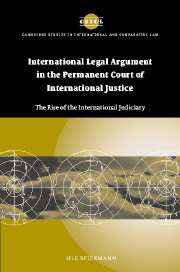 International Legal Argument in the Permanent Court of International Justice
International Legal Argument in the Permanent Court of International Justice Published online by Cambridge University Press: 17 July 2009
The Permanent Court as composed after the second general election
President Adatci and other new judges
The second general election of judges took place on 25 September 1930. Those re-elected were Judges Altamira (sixty-four years old), Anzilotti (sixty-one years old) and de Bustamante (sixty-five years old), who had been ordinary members of the Permanent Court since 1922; Judges Negulesco (fifty-five years old) and Wang (forty-nine years old), who had also been members of the Permanent Court since 1922, though in the first nine years as deputy-judges; and Judges Hurst (sixty years old), Fromageot (sixty-six years old) and Kellogg (seventy-four years old) (ages stated as at the end of 1930).
Only Judges Negulesco and Wang were younger than Judge Huber; Judge Huber, however, had eventually declined to stand for re-election. Huber's influence had diminished during Judge Anzilotti's presidency, partly because he had taken up the presidency of the International Committee of the Red Cross. Yet his departure was a serious blow to an international lawyer's approach to international legal argument, one which combined the international law of coexistence with the dynamic structure of international legal argument, having the conception of the state as an international sovereign as its starting-point. The main exponent of this approach remaining on the bench was Judge Anzilotti, since Deputy-Judge Beichmann did not secure re-election. Indeed, no Scandinavian candidate succeeded. Åke Hammarskjöld lost the last seat on the bench by a whisker to a South American, Francisco José Urrutia (Colombia).
To save this book to your Kindle, first ensure [email protected] is added to your Approved Personal Document E-mail List under your Personal Document Settings on the Manage Your Content and Devices page of your Amazon account. Then enter the ‘name’ part of your Kindle email address below. Find out more about saving to your Kindle.
Note you can select to save to either the @free.kindle.com or @kindle.com variations. ‘@free.kindle.com’ emails are free but can only be saved to your device when it is connected to wi-fi. ‘@kindle.com’ emails can be delivered even when you are not connected to wi-fi, but note that service fees apply.
Find out more about the Kindle Personal Document Service.
To save content items to your account, please confirm that you agree to abide by our usage policies. If this is the first time you use this feature, you will be asked to authorise Cambridge Core to connect with your account. Find out more about saving content to Dropbox.
To save content items to your account, please confirm that you agree to abide by our usage policies. If this is the first time you use this feature, you will be asked to authorise Cambridge Core to connect with your account. Find out more about saving content to Google Drive.